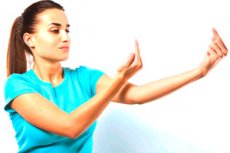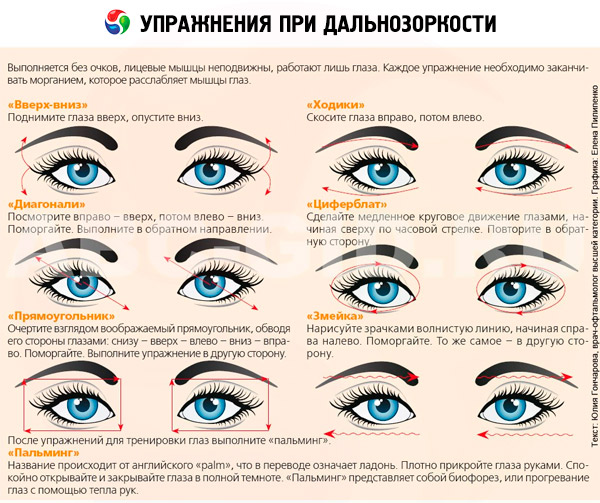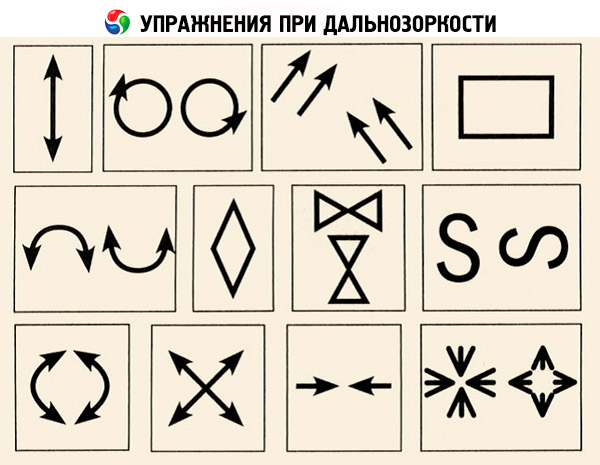Exercises for the eyes with farsightedness for children and adults by Zhdanov and Bates
Last reviewed: 23.04.2024

All iLive content is medically reviewed or fact checked to ensure as much factual accuracy as possible.
We have strict sourcing guidelines and only link to reputable media sites, academic research institutions and, whenever possible, medically peer reviewed studies. Note that the numbers in parentheses ([1], [2], etc.) are clickable links to these studies.
If you feel that any of our content is inaccurate, out-of-date, or otherwise questionable, please select it and press Ctrl + Enter.

Hyperopia or hypermetropia is a pathological condition characterized by a lack of correct focus of vision when considering subjects that are at close range. With normal vision, the image of the subject clearly falls on the retina of the eye, is transformed into nerve impulses, is recognized and analyzed by the brain. Presence of hyperopia changes refraction and shifts focus. A clear image of the object appears as if behind the retina. On the delicate nervous inner shell of the eye, the fuzzy outlines of the object under consideration fall. This pathology can provoke:
- individual shape of the eyeball with a shortening along the longitudinal axis;
- age-related changes in the accommodation of the lens;
- insufficient refractive power of the optical system of the organ of vision.
The first alarming symptoms of the disease are:
- eye fatigue when considering subjects near;
- high fatigue during reading;
- a feeling of fatigue when performing painstaking work that requires eye strain;
- the appearance of pathologies of an inflammatory nature.
To correct this pathology, doctors recommend the proper selection of appropriate contact lenses, glasses, drug therapy or surgery. A combination of drug therapy and the treatment of hyperopia by exercises that help to strengthen, reduce tension and relax the oculomotor apparatus is possible.

Exercises to improve and restore vision with hyperopia
Doctors-ophthalmologists successfully apply training gymnastics for different structures of the eye with hypermetropia. The combination of special exercises helps slow the progression of the process, which violates visual acuity. Training exercises for the eyes are recommended for the prevention of eye pathologies in childhood and young age, when the eyes are subjected to regular excessive stress and experience constant fatigue.
Effective treatment of hyperopia exercises helps to restore visual acuity and prevents its deterioration. Thanks to the technique:
- Improves circulation in the cervical spine.
- Microhemodynamics in the tissues and structures of the eye increases.
- The oculomotor apparatus is strengthened.
- The ability of the lens to normal accommodation is stimulated and maintained.

Exercises for farsightedness in Zhdanov
For various diseases and pathological conditions of the eyes, Professor V. Zhdanov developed a certain training system. Their basis was formed by traditional ideas about the principle of the work of the organ of vision.
The treatment of hyperopia by exercises according to the method of Professor V. Zhdanov requires patience, time and strict observance of the rules. Regular and accurate performance of gymnastics for oculomotor muscles will give a positive effect. Before the training: you must follow the following rules:
- Remove glasses or lenses (if any).
- Patients with retinal pathologies should exercise carefully and carefully.
- Repeat each exercise at least three times.
The effectiveness of the complex of gymnastics in hypermetropia is based on the training of the motor muscles of the eye through the emergence of alternating tension and relaxation, bringing nearer and removing the fingers of the upper limbs.
"The first finger of the hand":
- The fingers of one hand are gathered into a fist.
- Lift up the big first finger, showing "OK", holding out a hand forwards, blink two or three times, look into the distance, then focus on the withdrawn finger for 5 seconds. Gradually lower your hand down.
- The number of repetitions is 5 to 10 times.
"Moving a finger":
- The fingers of his right hand are clenched into a fist.
- Push the index finger forward.
- Bring your hand to your face so that your index finger is located at the level of the eyeball.
- To look into the distance.
- Start fast movements with your index finger from side to side, trying not to focus attention on your finger.
- Without changing the height, it is necessary to take a 20 cm hand to the left, return to the starting position, and move the fist to the right by 20 cm.
- Doing these movements follow the index finger with your eyes.
- Repeat exercise 2 min.
In order to improve cerebral circulation in the treatment of hyperopia exercises, professor ophthalmologist V. Zhdanov recommended complex fortifying charge. Complex training should be done in the morning and evening. The number of repetitions of each exercise is not less than 5.
- Turn your head from side to side.
- Tilt your head up and down.
- The starting position (IP) is standing. Tilt the head to the right. Return to the starting position. Tilt the head to the left.
- Shoulders move up and down.
- Rotational movements shoulders back and forth.
- Shoulders move forward, then back. In this case, the back and chest are alternately rounded.
- Stand your legs together. Do not shift your legs from the starting position to make the shoulder turns forward.
- PI as in paragraph 7 - turning the shoulder back.
- Starting position standing. Take your hands in the castle. Carry the body back to the right. Hold for 5 seconds in this position. Return to the FE. Twisting the body to the left back.
- Tilts to the sides.
 [1]
[1]
Exercises for children with hyperopia
In childhood, high-grade hypermetropia, as a rule, is a consequence of congenital pathologies that are eliminated by surgery. It must be remembered that the child's eye and its focusing and refractive structures are in constant development, and it is possible that over time, hypermetropia will be reduced to a minimum or completely disappear. In childhood, exercises for the complex treatment of hyperopia give a positive effect with an average and low degree of symptomatology of the disease. Gymnastics, which trains the accommodative apparatus, simultaneously stimulates its development and improves its functionality. It is difficult for young children to concentrate on gymnastics to strengthen the muscles of the eye. For the successful holding of gymnastics use various means and conduct trainings in the form of a game.
To combat hyperopia in childhood, the following gymnastic complex of exercises is used:
- Easy massage of the eyeballs of the child with fingertips with closed eyelids. Duration of the procedure is 5 sec. Number of repetitions - 5, between them rest - half a minute. Accelerates the circulation of the aqueous humor (humor aquosus).
- Kid to lay horizontally on the back. Attract his attention to your favorite toy. When the child focuses his eye on the object, it is necessary to slowly bring the toy closer to his eyes, moving the object "snake". It is advisable to monitor the child and watch whether he has focused his eye on the subject. The number of repetitions of the exercise at the initial stage is no more than 2 times, then the amount is increased to 5. When performing this gymnastics, the ciliary muscle is actively working and the accommodation mechanism is being trained.
- This training for complex treatment of hypermetropia is suitable for toddlers who are able to walk independently and perform simple tasks. The training game will be interesting for children aged 2 to 5 years. It is necessary that the child focuses his attention on the bright ball. Then throw the toy forward. The kid watches the toy with his eyes, finds it and brings it back. Another option for doing this exercise. It is necessary to put the child on the floor, and the adult to sit opposite, at a distance of 2-3 meters and roll the ball to each other. The kid should carefully observe the movement of the rolling toy, so that it does not "get lost, do not get lost and not get lost." This charge for the eyes is carried out for 5 minutes. It promotes stimulation of visual accommodation.
- Exercise is suitable for kids who learn to repeat the movements of others. It is necessary to pay attention to the child with simple grimaces, so that he fixes a look on the face of an adult. The game-training consists in the repetition of actions. You should close your eyes one by one and open them one by one. This exercise will help improve blood supply and activate metabolic processes in all structures of the eye.
- Training of eye muscles for children who can read. Take a bright book with large letters, which corresponds to the age of the baby and invite him to read a couple of lines from a comfortable distance. Then bring the book to the child (at 15 cm) and ask him to read 2-3 lines again. Training is done every day for 5 minutes. It is necessary to gradually bring the book closer to the child to the standard distance.
Older children will be interested in sports games with ball or volancher - cricket, volleyball, golf, table or tennis, basketball, badminton. These sports will help in the complex treatment of hypermetropia and will affect the accommodation mechanism of the eye and the visual system as a whole.
Complex of exercises for the eyes at farsightedness at home
Regular performance of a complex of exercises for the eyes with hypermetropia will stabilize the function of the eye muscles responsible for the tension and relaxation of the lens. The following exercises are recommended to be performed twice a day:
- It is necessary to move the eyes from left to right and upwards down, 7 times for each pair of directions.
- Stick a dark circle with a size of 10x10 mm on the glass. The patient becomes 1-2 m from the window and looks at the label. Then you need to look through the label in the distance without fixing a look at it. The number of repetitions is 5 times. After repeating the exercise, you need to blink your eyes 3 times.
- To follow the movement with your eyes, as if drawing a sign of infinity, a bow, a triangle, a square, a star, a spiral. Each imaginary figure is surrounded by a look through the contour.

To correct visual acuity disturbances, you can do it using the Sivtsev table, which is located in each of the ophthalmologist's offices. Before starting the exercises for the treatment of hyperopia, you must print 2 variants of the table: one - in full size, another - on a sheet of smaller format. Attach a large leaf to the wall. "Reading" is the tracking of the eyes along the line spacing (white horizontal gaps). Daily "reading" must begin with a sheet of smaller format. For several minutes, using not bright illumination, it is necessary to "read" a small table. In the evening for lighting you can use an ordinary paraffin candle.
Then you need to go to the "reading" table, fixed on the wall. The distance from the table to the patient should be at least 5 m. Lighting, as in the first task, should be gloomy. "Read" until there is tension and fatigue in the eyeballs. After this, a short rest is required, and then "reading" is resumed, but the illumination conditions change.
Take a small table, make good lighting, at the same time a large table remains darkened. First read the table on the wall, then quickly look at the small table. Do a few repetitions. When the eyes get tired, you must stop the session of the training exercises.
More than 100 years ago, the American ophthalmologist W. Bates expressed his opinion on the principles of the human eye. According to his theoretical views, most of the problems with the organ of vision arise from eye fatigue. The scientist has developed his complex of training and exercises for the treatment of hyperopia:
- It is necessary to present a palette of saturated colors: blue, green, red, yellow and others. Saturation of the hue is maximum. Each color can not be played back more than 1 second. The duration of the exercise is from 5 to 10 minutes.
- In the book, find a letter or picture and look at it from a convenient distance. Then close your eyes and present the object as clearly as possible. Exercise is considered complete if the imaginary image appears in thoughts of a darker shade than the real one.
- Mentally imagine a beautiful flower. Then expand the idea of it with the help of granularity (leaves, stem, petals, insects creeping over the flower, etc.). Exercise takes a long time, without exerting stress on the eyes. The object is located at a distance from which the imaginary details are clearly visible.
If you perform exercises for the treatment of hyperopia accurately, regularly, adhering to the technique of W. Beits in combination with rational nutrition, vitamin therapy, problems and complications with the organ of vision can be avoided.
 [4]
[4]
Exercises from farsightedness at home
To normalize the vision when overexerting (working at a computer, preparing for exams, watching TV), it is necessary to do simple exercises. Training to prevent the occurrence of hyperopia and other diseases of the organ of vision will relax the oculomotor muscles, relieve fatigue, relieve the unpleasant sensations of dryness and burning sensation in the eyes. At home, ophthalmologists recommend the following exercises:
- Blink for 1 minute without effort.
- Perform rotational movements of the eyes - first clockwise, then against. Repeat 5-10 times.
- Alternately, look to the left, then to the right, without turning your head. Run 10 repetitions.
This simple complex of gymnastics for the eyes can be conducted in any conditions - at home, in the office, in classrooms. A complex of simple exercises can be performed even by a child.

Yoga is useful for adults and children to enhance overall health. Yoga classes are aimed at treating, resuming and normalizing the work of the whole organism. Among the numerous asanas, there is a set of exercises for the treatment of hyperopia. Regular performance of health-improving yoga gymnastics with an emphasis on training to improve vision, will strengthen and increase the elasticity of the oculomotor muscles. The gymnastic complex activates the blood supply to the tissues and structures of the eye, enhancing the influx of nutrients and oxygen.
When hypermetropia will be useful solarization, trataka and inverted asanas.
Solarization is a method of normalizing the visual function by sunlight. Correct exercise will help to increase blood circulation in the oculomotor muscles and retina, inflammation in any eye structures will decrease, the adaptive ability of the eyes will be activated with a contrast change in the brightness of the illumination. With the correct and regular performance of solarization exercises, one can significantly improve vision or significantly slow down pathological destructive processes when age-related hypermetropia occurs.
It is necessary to start the morning, substituting the closed eyes to the sun. After a while, you can open the upper eyelid and look down, so that the sun's rays hit the sclera. It is necessary to start from 1-2 minutes, gradually increasing to 10 minutes. This procedure can only be done in the morning or evening.
Trataka - an exercise for the treatment of hyperopia is based on the concentration of attention on the tip of the candle flame. Exercise is performed in a quiet quiet place, taking a pose for meditation and relaxing the body. You need to light a candle and focus your gaze on the top of the flame. Then close your eyes and display the flame of the candle in your memory most clearly and clearly. If the image can not be clearly imagined, then you need to open your eyes and look again at the flame. When the imaginary image is clear and looks like a real burning candle - stop the exercise.
Inverted asanas or anti-gravity postures when the legs are above the head. In Hatha Yoga, it is believed that royal asanas slow the aging process and reduce the impact of the force of gravity on the body. Mastering such exercises is important for vision correction, because the blood, flowing to the head, saturates all tissue structures, including eye tissues, oxygen, and useful substances. Inverted asanas also have contraindications. This is increased intraocular pressure or eyeball injuries. Inverted asanas are Sarvangasana or Candle, Halasana or Plow, Viparita-karni-mudra (inverted action).
Gymnastics for relaxation of the eye muscles in combination with diet therapy and physical exercises will undoubtedly benefit people with vision problems, including those with hyperopia, and will also become a good prevention of eye diseases.
 [5]
[5]

